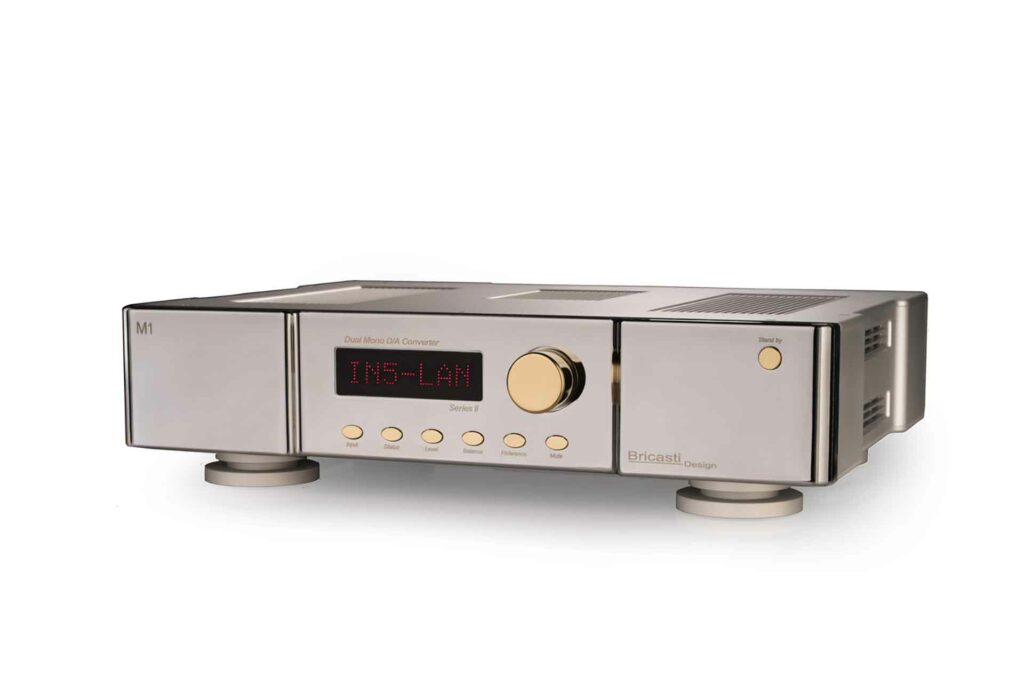Bricasti Design just launched the newly engineered Bricasti M1 Series II (read the review) dual mono digital to analog converter.

The M1 Series II introduces a new look and feel to the M1 series of products and encompasses many elements of Bricasti Design’s vast wealth of experience engineering precision D/A’s to transform the M1 with the audio purist in mind. The M1S2 is focused on simplicity of design and includes a host of new performance milestones including our latest MDx processor, new higher current twin linear power supplies with larger performance capacitors, all fit into a handcrafted chassis milled from solid aluminum that stands taller in size fitted with the same M1SE feet as standard.
Beautifully finished in Classic, Argento or Platinum Series styles, the M1 Series II is stunningly expressive and built to exacting standards in the United States.
The M1 Series II is available for immediate delivery, MSRP is $12,000 in classic series black or argento finishes, and $15,000 in platinum series finish.
The Audiophile History of Bricasti Design
Bricasti Design is a Massachusetts-based audio company best known for its high-end digital-to-analog converters (DACs), network players, and professional reverb units. While the brand itself is relatively young—founded in 2004—its roots run deep in both the audiophile and professional recording industries. The company’s founders, Brian Zolner and Casey Dowdell, came from long tenures at Lexicon, a pioneering force in digital signal processing and reverb design. At the time of Bricasti’s formation, Lexicon was under the Harman International umbrella, and its influence on digital audio was far-reaching. The transition from that legacy into a new, independent company shaped the direction and design philosophy of Bricasti from the beginning.
Zolner, who worked in sales and product development at Lexicon, brought a strong sense of what high-performance users—both professional and audiophile—demand from digital equipment. Dowdell, an engineer, contributed deep technical experience in digital signal processing. Together, they founded Bricasti with the idea of producing state-of-the-art digital audio products that could serve both mastering studios and high-end audio playback systems.
The company’s first product, the Model 7 Stereo Reverb, launched in 2007, was aimed at the professional studio market and immediately attracted attention for its clean, musical sound and intuitive interface. The M7 was designed as a modern successor to the classic Lexicon 480L and 960L reverb units, which had become staples in recording and mixing environments worldwide. The M7 found a home in mastering and mixing studios thanks to its flexible control, rich algorithm design, and physical build quality. While not designed for audiophile use, the M7 built credibility for Bricasti in circles where audio quality is critically evaluated.
Shortly after the M7’s release, Bricasti expanded into the audiophile market with the M1 Digital-to-Analog Converter. This product became the company’s signature audiophile piece, offering dual-mono DAC architecture, discrete analog output stages, and an array of user-selectable digital filters. It was designed with the same principles found in their professional gear—low noise, linearity, and careful clocking—but adapted for high-resolution playback in domestic listening environments. The M1 DAC was well-received for its neutral tonal balance and ability to resolve detail without sounding clinical. It quickly found favor among listeners using high-end digital sources and was compatible with a range of playback software and transports.
Bricasti’s approach to digital design is marked by its avoidance of off-the-shelf solutions. The company designs its own analog stages and power supplies, and often builds its digital sections around programmable logic rather than pre-made chipsets. This level of control allows Bricasti to tailor the sonic characteristics of their products and provide firmware updates that enhance performance over time. It also places them in a rare category of companies that design holistically from the power supply to the output stage.
Another hallmark of Bricasti products is the build quality. The company manufactures all of its products in Massachusetts, with milled aluminum enclosures, modular circuit boards, and careful internal layout. This attention to mechanical and electrical design has contributed to Bricasti’s reputation for durability and consistency. The aesthetic is minimalist and functional—more reminiscent of studio equipment than decorative consumer audio—but it speaks to the brand’s origins in professional sound.
Over time, Bricasti expanded the M1 DAC into several variants, including the M1 SE and M1 Series II, each introducing incremental refinements. They also added products like the M3 DAC, a more compact and affordable version of the M1 aimed at broader adoption in high-end systems, and the M21 DAC, which incorporates both delta-sigma and R-2R ladder DAC architectures for users to choose between.
The company’s ecosystem grew to include the M5 Network Player, a streaming transport designed to work with the M1 and M3 DACs. The M5 supports high-resolution streaming formats and integrates with Roon, which has become a standard in high-performance digital audio playback. Like other Bricasti products, it is engineered with attention to clocking, signal integrity, and low noise.
In the audiophile world, Bricasti has built a reputation for bridging the gap between studio-quality engineering and home listening needs. Their gear is often used by mastering engineers and audiophiles alike, which places Bricasti in a small group of companies whose products function equally well in both domains. Unlike many hi-fi brands that prioritize design flair or coloration, Bricasti focuses on accuracy, transparency, and long-term reliability.
The company’s philosophy remains closely tied to its founders’ backgrounds. The transition from Lexicon’s corporate structure under Harman to a small, independent company gave Zolner and Dowdell the freedom to focus exclusively on quality and performance without compromise.



